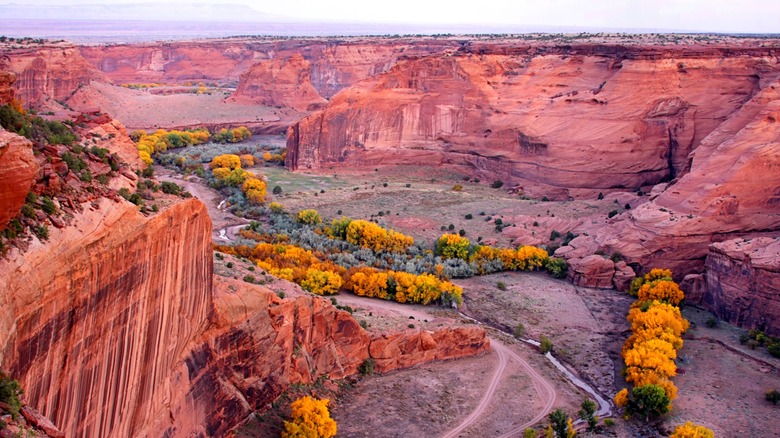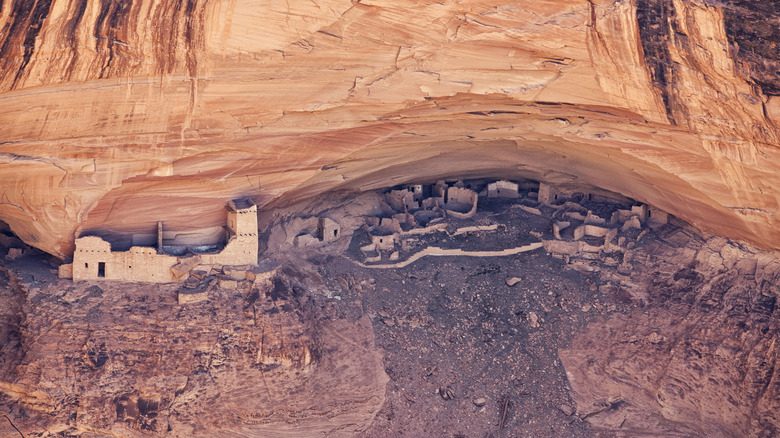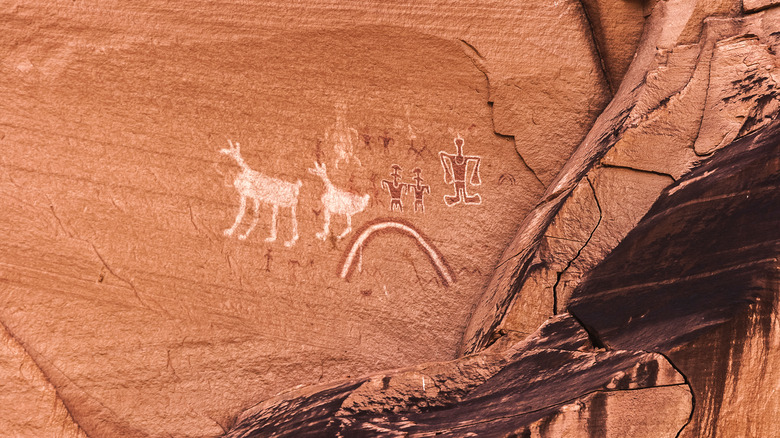This Arizona National Monument Is Arguably As Iconic And Picturesque As The Grand Canyon
It's a pretty safe bet that you've heard of the Grand Canyon, the most filmed park in the U.S. The massive trench carved through stone over millions of years has captured the imagination of generations. However, the United States is full of natural wonders, and one of them is just as beautiful, just as awe-inspiring, and just as worthwhile to visit. This spot is Canyon de Chelly National Monument in Arizona (pronounced "duh-SHAY"). This area sits in the Navajo Nation, has been inhabited for around 5,000 years, and is to this day.
Inside this canyon are remnants of that habitation by the ancient Puebloans, the Hopi, and the Navajo, who still farm in the area. It was also the site of a sad chapter in history. Many Navajo were killed when troops entered the canyon in 1863, and the rest were forced from their homes and marched 300 miles to Fort Sumner in New Mexico. They were finally able to return in 1868 to rebuild.
Canyon de Chelly was declared a National Monument in 1931 by President Herbert Hoover. When you visit, you can see the ruins of some of the ancient dwellings (with a caveat, which we'll explain) and cave paintings, learn about the natural history of the area, and enjoy the incredible natural beauty of this place. Here's what you need to know before you pay a visit to Canyon de Chelly.
Visiting Canyon de Chelly
There is no fee to visit Canyon de Chelly, and there's free parking at the welcome center. The lot and center are open from 8 a.m. through 5 p.m., and it's worth stopping to learn more about the area you're about to visit. You have several options for your exploration. First, you can take your car along the two paved rim drives (north and south) to look into the canyon. They're open all year round. Two hours are recommended for each path, but the North Rim is better for pictures in the morning, and the South Rim is better in the afternoon, lighting-wise.
While there was once a self-guided hike, it is now closed until further notice, as is the White House Overlook and Trail after some break-ins and vandalism. The White House area is where many dwelling remains are, so that's bound to be a disappointment. However, you can take a private canyon tour from a list on the official park site. These will take you past the ruins and allow you to see them, though they're behind a barricade. Private tour companies are registered with the Navajo Parks and Recreation Department, and you can contact them directly. There are options for tours in vehicles, on foot, and on horseback. You'll also be taken to see some of the ancient cave paintings in the canyon, which are stunning. Note that private tours have a fee, and you'll need a backcountry permit ($8 per person), so check with your tour company as they may provide it.
Experiences in Canyon de Chelly
There are other ways to experience this astonishing place, including free ranger programs and celebration of events like the park's birthday on April 1, National Public Lands Day, Halloween, and Native American Heritage Month. You can also sign up for group hikes, but get there early as they can only accept the first 15 people. You can get details on the park's Facebook Page and in the welcome center. Another option is camping, and the idea of a night under the stars in this ancient and historic place is enticing. You can call the Navajo Parks and Recreation Department for more details about availability and fees to stay at Cottonwood Campground.
There are a few important details that you must keep in mind throughout your visit. First, this is a historic site that has seen both happy and terrible events. Please be respectful of where you are and what it means. This is a unique opportunity to learn more about the area's history and culture, but remember that people do live here, so stay on designated paths.
Fall can have flash floods that you may not see coming. Follow all posted signs, and if it's closed, it's for good reason. Make sure you know the symptoms of dehydration and how to rehydrate, especially in the summer when it can be nearly 100 Fahrenheit. Reception is spotty in the canyon, so download what you need, tell people where you'll be, and plan your route before you visit. While in Arizona, here is a cactus rule you shouldn't break.


